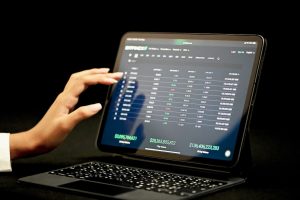Forex is a global marketplace where currencies are traded. The forex market is the largest financial market in the world, with an average daily turnover of $5.3 trillion. Forex is a decentralized market, which means that there is no central exchange. Instead, forex trading takes place over-the-counter (OTC) via banks, brokers, and dealers. Forex trading involves buying one currency and selling another currency simultaneously. The price at which the currencies are exchanged is called the exchange rate. The exchange rate can fluctuate based on a variety of factors such as economic data, geopolitical events, and central bank actions.
Forex trading involves trading currency pairs. A currency pair is the quotation of two currencies, with the value of one currency being quoted against the other currency. For example, the EUR/USD currency pair represents the euro currency being quoted against the US dollar. The first currency in the pair is called the base currency, and the second currency is called the quote currency.
Forex correlation pair means a pair of currencies that are positively or negatively correlated. Correlation refers to the relationship between two variables. In forex trading, correlation refers to the relationship between two currency pairs. Correlation can be positive or negative. A positive correlation means that two currency pairs move in the same direction. A negative correlation means that two currency pairs move in opposite directions.
For example, the EUR/USD and GBP/USD currency pairs have a positive correlation. This means that when the EUR/USD currency pair goes up, the GBP/USD currency pair also goes up. When the EUR/USD currency pair goes down, the GBP/USD currency pair also goes down. This is because the euro and the British pound are both European currencies, and they are affected by similar economic factors.
On the other hand, the USD/JPY and USD/CHF currency pairs have a negative correlation. This means that when the USD/JPY currency pair goes up, the USD/CHF currency pair goes down. When the USD/JPY currency pair goes down, the USD/CHF currency pair goes up. This is because the Japanese yen and the Swiss franc are both considered safe-haven currencies, and they are affected by different economic factors than the US dollar.
Forex correlation pairs can be used in forex trading to hedge positions and to diversify a trading portfolio. Hedging is a strategy where a trader takes a position to offset the risk of another position. For example, if a trader has a long position in the EUR/USD currency pair, they can hedge their position by taking a short position in the GBP/USD currency pair. This is because the EUR/USD and GBP/USD currency pairs have a positive correlation. If the EUR/USD currency pair goes down, the GBP/USD currency pair will go up, and the trader will offset their losses.
Diversification is a strategy where a trader spreads their risk across different assets. By trading forex correlation pairs, a trader can diversify their portfolio and reduce their overall risk. For example, if a trader has a long position in the USD/JPY currency pair, they can diversify their portfolio by taking a short position in the USD/CHF currency pair. This is because the USD/JPY and USD/CHF currency pairs have a negative correlation. If the USD/JPY currency pair goes down, the USD/CHF currency pair will go up, and the trader will offset their losses.
In conclusion, forex correlation pairs refer to pairs of currencies that have a positive or negative correlation. Positive correlation means that two currency pairs move in the same direction, while negative correlation means that two currency pairs move in opposite directions. Forex correlation pairs can be used in forex trading to hedge positions and to diversify a trading portfolio. By trading forex correlation pairs, traders can reduce their overall risk and increase their chances of success in the forex market.





